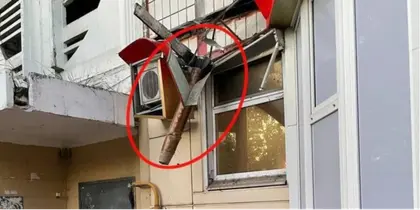An explosion on July 3 in the Russian city of Belgorod killed three people and injured four others. There was also, according to preliminary reports, damage to eight private houses, three high-rise buildings, and six cars. But so far, the reason for the strike has not been identified.
Both national and international media outlets continue to debate who was responsible for the attack, with the citizens of Belgorod, located in Russia, 30-40 kilometers from the Ukrainian border, reported to be demanding an explanation from local authorities.
JOIN US ON TELEGRAM
Follow our coverage of the war on the @Kyivpost_official.
Russian media channels reported that the Ukrainian Armed Forces (UAF) hit Belgorod with Tochka-U missile systems and reconnaissance drones filled with explosives. However, after the attack, the first stage of a Russian surface to air missile system Pantsir was found to have fallen on a multi-store building in the city, suggesting that the Russian military – most likely unintentionally – caused at least some, if not all, of the damage.
There are several theories circulating in news outlets and on social media as to why Russian armed forces may have fired the missile that struck Belgorod:
- President Vladimir Putin wants to add victims among Russia’s own civilian population to justify the necessity of the war with Ukraine.
- The attack was carried out to disrupt the supply of Western weapons, on the basis that Ukraine reportedly promised U.S. President Joe Biden that they would not be fired at the territory of the Russian Federation.
- A UAF Belgorod attack, on Russian soil, is “needed” by the Kremlin to justify a general mobilization in Russia.
- Russian army air defense troops around Belgorod spotted Ukrainian Armed Forces (UAF) aircraft, fired a Pantsir missile or missiles, missed, and the Russian weapon or weapons hit civilian infrastructure when falling to Earth.
- Russian army air defense troops around Belgorod misidentified a clear sky or friendly aircraft or missiles as an incoming UAF strike, and fired the anti-aircraft missiles.
Although – at least theoretically – the incident marked a deadly UAF attack against Russian citizens and property, on Russian soil, President Putin has thus far made no comment at all on what it was – or what it wasn’t – that the Pantsir missile was supposed to hit, in the night sky over Belgorod on July 3.

British Defence Intelligence Update Ukraine 23 January 2025
RF state-controlled media subsequently claimed, without providing evidence, that no less than three UAF Tochka-U surface-to-surface missiles were intercepted by Belgorod air defenses, and that one of the interceptor missiles hit civilian structures after blowing up a UAF weapon in the air.
Belgorod Mayor Anton Ivanov, in a July 3 statement, told reporters that 26 apartment buildings and 46 homes were damaged as a result of the UAF “attack”. He did not make clear, however, what portion of the damage was due to falling RF interceptor missiles. Instead, Ivanov blamed Ukraine, but offered no evidence.
On the Ukrainian side, Anton Herashchenko, an Interior Ministry spokesman, in a July 3 Telegram-published analysis, argued that RF forces based in on the night in question launched surface-to-surface missiles to attack the Ukrainian city Kharkiv, and that RF air defenses in the area, in error, shot down some of the Russian attack missiles. Like his Russian colleagues, Herashchenko offered zero evidence to back up the theory.
In televised comments, Belgorod Oblast’ Governor Vyacheslav Vladimirovich Gladkov told local residents that the single ground explosion was preceded by “a series of loud sounds, claps and the operation of the air defense system.”
Asked by a Belgorod voter “How can we sleep peacefully now?” Gladkov offered no details, answering: “I can’t say that this will never happen again.”
You can also highlight the text and press Ctrl + Enter










